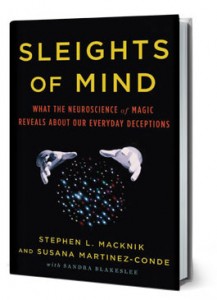Magic Reveals Insights for Cognitive Designers
Sunday, June 3rd, 2012I’m often asked for good examples of cognitive design. Some of the best are:
Powerball (multi-million dollar jackpot lottery tickets), Angry Birds (a mobile game), the Dom Zu Kohn (cathedral in Germany), your favorite piece of art, using the placebo effect to heal, pictures of cute baby animals, the alert tone on a cell phone and magic tricks you can’t see even after they are explained.
The success of all of these artifacts turns on the fact that they generate far more mental energy than it takes to interact with them. They deliver a powerful think-and-feel experience because features and functions are optimized for how our minds actually work. Said another way, they reveal the secret sauce for how to design for psychological impact . They are a laboratory for applied cognitive scientists and a potential design pattern for innovators.
So far our attempts at applying the lessons learn from these artifacts to other design problems has seen little success. For example, serious games (i.e. application of game mechanics to education, health and and business) have yet to produce a block buster and lottery-based savings products have yet to make a dent in our need to prepare for retirement.
 Cognitive design needs to mature. One strategy is to get much better at translating the results of cognitive science and engineering into innovations that authentically move our hearts and accelerate our minds. What we need are scientific studies of artifacts with high cognitive impact that are specific enough to offer design insights. For example, actionable research on the visual neuroscience of magic has come out of the Barrow Neurological Institute. In a recent press release they shared these findings:
Cognitive design needs to mature. One strategy is to get much better at translating the results of cognitive science and engineering into innovations that authentically move our hearts and accelerate our minds. What we need are scientific studies of artifacts with high cognitive impact that are specific enough to offer design insights. For example, actionable research on the visual neuroscience of magic has come out of the Barrow Neurological Institute. In a recent press release they shared these findings:
“The researchers discovered that curved motion engaged smooth pursuit eye movements (in which the eye follows a moving object smoothly), whereas straight motion led to saccadic eye movements (in which the eye jumps from one point of interest to another).”
“They studied a popular coin-vanishing trick, in which King tosses a coin up and down in his right hand before “tossing” it to his left hand, where it subsequently disappears. In reality, the magician only simulates tossing the coin to the left hand, an implied motion that essentially tricks the neurons into responding as they would have if the coin had actually been thrown. “
These have very specific implications for designers. For a deeper dive into the neuroscience behind magic check out Sleights of Mind and the Best Illusions of the Year Contest.
It is interesting to note that magic was developed through experimentation and tradecraft. Neuroscience is trying to catch up but once it does we should see a new type of magic emerge. The same it true for games, art and much of architecture, marketing, education and entertainment. Tradecraft trumps science’s ability to generate breathtaking think-and-feel experiences but for how long?